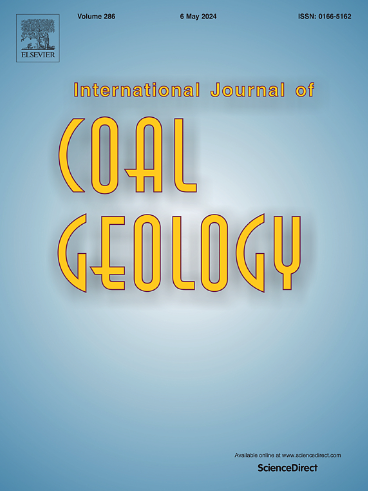黑色页岩中放射性物质的降解:一个被忽视的有机分子结构的修饰
IF 5.7
2区 工程技术
Q2 ENERGY & FUELS
引用次数: 0
摘要
沉积盆地中铀(U)释放的天然放射性辐射不断转化有机质,其降解作用覆盖了埋藏相关的热成熟过程。然而,沉积有机质辐照蚀变的系统途径及其影响尚不清楚。这种遗漏妨碍了对埋藏后有机质演化的全面认识。研究了北欧寒武系—奥陶系富铀明矾页岩和鄂尔多斯盆地三叠系长7-3页岩中有机质的人工和自然辐照蚀变。样品暴露于Co-60源后,辐射加速了沥青向天然气的转化,天然气干燥度较低(C1/C1 - 5 < 0.8),而干酪根则转化为天然气,天然气干燥度较高(>0.8)。此外,当辐射剂量分别达到约100和2000 kGy时,增强的辐射剂量有利于树脂和沥青质向芳烃的转化,并导致碳-13同位素的富集。根据U的空间分布和附相特征,长7-3页岩的自然辐射暴露可能通过加速宏观有机化合物向微观有机化合物的转化和湿气的生成来影响沥青结构,从而增强油气的流动性。此外,本文还提出了一个有机物质埋藏和转化的标准模型,并将自然辐射照射纳入其中。基于对沉积岩元古宙-显生宙辐射剂量的计算,我们假设放射性过程可能持续改变了富铀页岩中保留沥青的特征,从而影响了地球表面环境的碳循环。本文章由计算机程序翻译,如有差异,请以英文原文为准。
Degradation of organic matter by radioactive radiation in black shales: An overlooked modification of organic molecular structures
Natural radioactive radiation emitted by uranium (U) in sedimentary basins continuously transforms organic matter and thus its degrading impact overprints the burial-related thermal maturation process. However, the systematic pathway for irradiated alteration of sedimentary organic matter and its influence remain poorly understood. This omission hinders a comprehensive understanding of organic matter evolution after burial. Our study investigated the artificially and naturally irradiated alteration of organic matter in the U- and organic-rich Cambro-Ordovician Alum Shale of Northern Europe and Triassic Chang 7–3 shale in the Ordos Basin of China. After exposure of samples to a Co-60 source, radiation accelerated the conversion of bitumen to natural gas with a lower gas dryness (C1/C1–5 < 0.8), while kerogen is converted to natural gas with a higher gas dryness (>0.8). Moreover, enhanced radiation dose facilitates the transformation from resins and asphaltenes to aromatics and leads to enrichments of carbon-13 isotope, when the radiation dose reaches the thresholds of approximately 100 and 2000 kGy, respectively. Natural radiation exposure in the Chang 7–3 shales, identified by spatial distribution and affiliated phases of U, may have influenced bitumen structures through accelerating transformation of macro- to micro-organic compounds and generation of wet gas that could have enhanced hydrocarbon mobility. Moreover, an addition to the standard model for organic matter burial and transformation is proposed with integration of natural radiation exposure. Based on the calculated Proterozoic-Phanerozoic radiation dose in sedimentary rocks, we hypothesize that the radioactive processes might have consistently modified the characteristics of retained bitumen in uranium-enriched shales, thereby affecting carbon cycle on Earth's surface environments.
求助全文
通过发布文献求助,成功后即可免费获取论文全文。
去求助
来源期刊

International Journal of Coal Geology
工程技术-地球科学综合
CiteScore
11.00
自引率
14.30%
发文量
145
审稿时长
38 days
期刊介绍:
The International Journal of Coal Geology deals with fundamental and applied aspects of the geology and petrology of coal, oil/gas source rocks and shale gas resources. The journal aims to advance the exploration, exploitation and utilization of these resources, and to stimulate environmental awareness as well as advancement of engineering for effective resource management.
 求助内容:
求助内容: 应助结果提醒方式:
应助结果提醒方式:


